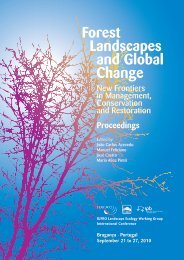Programa e Resumos - I Congresso Ibérico de Ciência do Solo 2004
Programa e Resumos - I Congresso Ibérico de Ciência do Solo 2004
Programa e Resumos - I Congresso Ibérico de Ciência do Solo 2004
Create successful ePaper yourself
Turn your PDF publications into a flip-book with our unique Google optimized e-Paper software.
I <strong>Congresso</strong> Ibérico da Ciência <strong>do</strong> <strong>Solo</strong> – 15 a 18 <strong>de</strong> Junho <strong>de</strong> <strong>2004</strong>, Bragança, Portugal<br />
Influence of tephra mulch thickness and grain-size on soil temperature.<br />
Francisco Díaz, Guacimara Mejías, Marisa Teje<strong>do</strong>r & Concepción Jiménez<br />
Dept. Edafología y Geología, Universidad <strong>de</strong> La Laguna, Facultad <strong>de</strong> Biología, Avda.<br />
Astrofísico Francisco Sánchez s/n, 38204, La Laguna, Tenerife, Islas Canarias, España – Tel:<br />
(+34) 922318368 – Fax (+34) 922318311 – E-mail: martesa@ull.es<br />
Abstract<br />
Comunicación: Poster<br />
In the present work, we examine the effect of tephra mulching (basaltic pyroclast) -in<br />
particular, grain size and mulch thickness- on soil temperature in an arid region of the<br />
Canary Islands (Spain).<br />
The study was carried out in seven experimental plots measuring 5.5 x 4.5 m 2 , each 1.5<br />
m apart and all in the same landscape position (slope < 1%). In each plot 40 cm of a soil<br />
typical of the area was placed (Haplocalcids,. with 694.5 g kg -1 clay, 252.2 g kg -1 silt,<br />
53.3 g kg -1 sand, 2.5 g kg -1 organic carbon, 1.8 dS m -1 CEs. The soils in all the plots<br />
were covered on the same day (August 1999) with a layer of basaltic tephra. The plots<br />
differed as regards the thickness of the covering and the mulch grain size. Three were<br />
covered with 10-cm basaltic pyroclasts of three different grain sizes (fine, medium and<br />
coarse). In a further three, layers of 5, 10 and 15-cm of medium-grain size mulch were<br />
used. One plot was left uncovered as a control. Temperature sensors were placed at 3-<br />
cm <strong>de</strong>pth in the soil in the centre of each plot. The PT100 sensors were connected<br />
throughout the experimental period to a microprocessor via a UTI signal conditioner in<br />
Wheatstone bridge mo<strong>de</strong>. Measurements were taken every half hour for an entire year<br />
(1 June 2000-30 May 2001). A full meteorological station installed in the zone took air<br />
temperature readings every 15 minutes at a height of 2 metres above ground. Total<br />
rainfall during the year was 34 mm and the average annual temperature 20.3ºC.<br />
All the mulches studied consi<strong>de</strong>rably reduced both diurnal and seasonal temperature<br />
fluctuations, although the effect on soil temperature differed according to the<br />
characteristics of the mulch. Thicknesses of 10 to15 cm of medium-grain tephra were<br />
found to be the most effective in maintaining a<strong>de</strong>quate temperatures for plant<br />
<strong>de</strong>velopment. Lower thicknesses as well as fine and coarse grain sizes had lower<br />
temperature attenuation capacity. These results are of practical interest in that they<br />
permit optimisation of farming systems based on the use of volcanic mulch.<br />
– 127 –
















